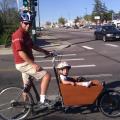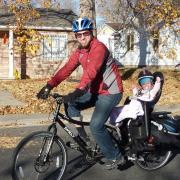When Deb Hubsmith founded the Safe Routes Partnership in 2005 – the same year that the first federal Safe Routes to School legislation was passed, authorizing funding to 50 states and the District of Columbia – her vision for the Safe Routes to School movement was much broader than the $612 million in initial funding outlined in the legislation. From the very beginning, Hubsmith believed that Safe Routes to School had the potential to transform our cities and towns into healthy, active communities where all people can walk, bicycle, and be physically active.
Resource Library
This website includes a fact sheet and package of school siting policies for school districts that want to ensure that their school siting decisions support the educational success, physical health, and overall well-being of students and their community.
 On September 17th, the U.S. House Transportation Committee will be voting on the transportation bill. One of the issues they’ll be debating is whether or not to continue the Transportation Alternatives Program (TAP), which is the main source of funding for Safe Routes to School, bicycling and walking.
On September 17th, the U.S. House Transportation Committee will be voting on the transportation bill. One of the issues they’ll be debating is whether or not to continue the Transportation Alternatives Program (TAP), which is the main source of funding for Safe Routes to School, bicycling and walking.
This study of traffic fatalities in a county in California found that pedestrian crashes are 4 times more frequent I poor neighborhoods and age of the population, education, English language fluency, nor population density explained the effect of income level.
This map provides examples of the impact of bicycling on business districts, jobs, and household savings across the country.
As many of you know, it’s award season! From the Golden Globes to the Screen Actor's Guild Awards and all the way to the Oscars… there are nominees and winners. Here at the Safe Routes Partnership we wanted in on the award season action. For the past year, the National Shared Use Task Force has been engaging in conversations about ways that we could recognize all of the great work that is happening across the country in the shared use field.
This report presents a school bicycle parking facility assessment tool and describes how to use it. It also presents ideas about how to make improvements to your bicycle parking facilities and shares the results from the original Eugene‐Springfield Safe Routes to School bicycle parking study.
 Sara Zimmerman is program and policy director at the Safe Routes Partnership.
Sara Zimmerman is program and policy director at the Safe Routes Partnership.
Click here to see the Storify highlights from the #MoveEquity Tweetchat on ending street harassment to get more kids walking and biking.
The majority of Americans live in urban or suburban areas, though around 15 percent of Americans live in nonmetropolitan regions, which make up 72 percent of US land. Although the proportion of Americans who are rural residents has recently declined, these communities still comprise 46.1 million Americans (USDA, 2015). When it comes to health outcomes, researchers have identified inequities in rural areas, including higher rates of obesity compared with urban residents and differing levels of physical activity by geographic region (Yousefian et al., 2009; Hansen and Harley, 2015).
Back in May, we asked you to take action against the US Department of Transportation’s (USDOT) proposed “system performance measures” that would have measured the speed of cars and trucks in seven different ways, while devoting no measures at all to people walking, bicycling, and taking transit.
 In Atlanta, I’m sitting in a conference room with roughly 30 advocates from the public health sector who are here to talk about the work they are doing throughout the country in preventative health.
In Atlanta, I’m sitting in a conference room with roughly 30 advocates from the public health sector who are here to talk about the work they are doing throughout the country in preventative health.
 Hi, my name is Kathy Cooke, and I'm network coordinator for the Safe Routes Partnership! Even though I battle daily to get my two sons to put on a jacket or long pants during Portland's rainier months, I've found ways to make sure other "systems" are in place that help them get safely to and from school. We have tools at the ready to fix their bike brakes or pump air in their tires.
Hi, my name is Kathy Cooke, and I'm network coordinator for the Safe Routes Partnership! Even though I battle daily to get my two sons to put on a jacket or long pants during Portland's rainier months, I've found ways to make sure other "systems" are in place that help them get safely to and from school. We have tools at the ready to fix their bike brakes or pump air in their tires.
 Please note that the Request to Host for the 2013 Safe Routes to School National Conference was not released on April 16 as stated below. Stay tuned as we will send it out as soon as possible!
Please note that the Request to Host for the 2013 Safe Routes to School National Conference was not released on April 16 as stated below. Stay tuned as we will send it out as soon as possible!
 As I learn more about the communities in the Greater Washington, DC region, I am learning about the unique approaches and challenges to increasing walking and bicycling in each community. For example, some schools do not allow kids to walk or bicycle to school.
As I learn more about the communities in the Greater Washington, DC region, I am learning about the unique approaches and challenges to increasing walking and bicycling in each community. For example, some schools do not allow kids to walk or bicycle to school.
 From Bicycling Magazine to NPR's Talk of the Nation, the topic of Safe Routes to School is in the headings and creating a national conversation!
From Bicycling Magazine to NPR's Talk of the Nation, the topic of Safe Routes to School is in the headings and creating a national conversation!
 For the past two weeks veteran and budding bicyclists around the country have been peddling the joys of pedaling by participating in the National Bike Challenge , National Bike to S
For the past two weeks veteran and budding bicyclists around the country have been peddling the joys of pedaling by participating in the National Bike Challenge , National Bike to S
A Matter of the “Heart”
 Hi! Welcome to my blog.
Hi! Welcome to my blog.
 After several weeks of reports that Congressional conferees on the transportation bill were making progress, last week saw a flurry of news stories in the Capitol Hill trade press that negotiations are on the rocks. House Republicans from the Transportati
After several weeks of reports that Congressional conferees on the transportation bill were making progress, last week saw a flurry of news stories in the Capitol Hill trade press that negotiations are on the rocks. House Republicans from the Transportati
All Safe Routes to School programs benefit from evaluation. Thoughtful data collection and analysis helps communities to identify issues, appropriate strategies to address those issues, set goals, and determine results. Data collected can further influence funding by providing a fuller picture of community needs and prospective projects.
In our upcoming September webinar, we will delve into tools to support your funding applications and existing programs. The one-hour session will include an overview of Colorado’s EnviroScreen, an interactive environmental justice mapping and health screening tool developed for the Colorado Department of Public Health and Environment (CDPHE). This dynamic resource enables users to identify areas with current and past environmental inequities, pinpoint areas where disproportionately impacted communities have a greater health burden and/or face more environmental risks and identify geographic areas that meet the definition of disproportionately impacted communities under Colorado law.
Additionally, given the closure of the National Safe Routes to School Data System, we will be discussing new means of recording student travel tallies and parent surveys. This data is a required component for Colorado Safe Routes to School grant applications. All those interested in submitting applications for our upcoming Colorado Safe Routes to grant cycle, join us as we share our suggestions to help you prepare your best submission!
*Note: While this webinar is designed to give an overview of tools available for evaluation within your program, special attention will be given to attendees preparing a Colorado Safe Routes to School FY 25 Application.

